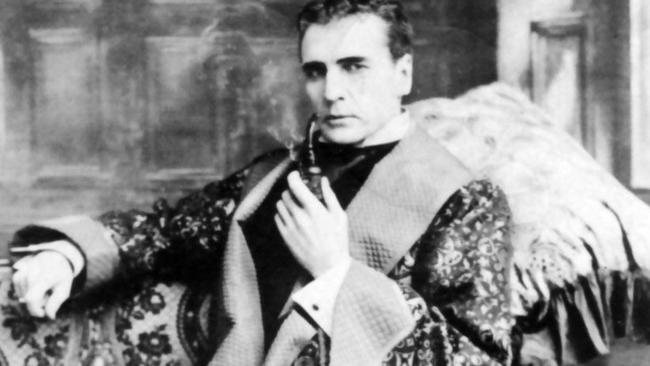Long-lost film revives suave screen portrayal of Sherlock Holmes
Sherlock Holmes was long dead by the time American stage star William Gillette joined forces with author Arthur Conan Doyle to resurrect the pedantic sleuth for the stage.

Today in History
Don't miss out on the headlines from Today in History. Followed categories will be added to My News.
Sherlock Holmes was long dead by the time American stage star William Gillette joined forces with author Arthur Conan Doyle to resurrect the pedantic sleuth for the stage.
In his stage adaptation, Gillette added idiosyncrasies that came to define literature’s most famous detective, including his curved pipe, deerstalker cap and flowing cape-jacket. By the time the play was adapted for screen in 1916, Gillette had played Holmes on stage more than 1300 times since his debut at the Star Theatre in Buffalo, New York, on October 23, 1899.
Long considered lost, a print of Gillette’s only screen portrayal of Holmes was found in a French film archive in October 2014. The film Sherlock Holmes is screening for the first time at the NSW State Library tomorrow as part of the Australian Silent Film Festival. Directed by Arthur Berthelet and produced by Essanay Studios in Chicago, the negative of the 90-minute film was restored in Italy under supervision by the San Francisco Silent Film Festival and la Cinematheque Francaise.
“William Gillette’s Sherlock Holmes has ranked among the holy grails of lost film,” San Francisco silent film festival president Robert Byrne said. “My first glimpse of the footage confirms Gillette’s magnetism.”
Doyle had killed Holmes off in 1893 in a battle against his adversary Professor Moriarty in The Final Problem. Then in 1897, he wrote a play called Sherlock Holmes and sent it to Herbert Beerbohm Tree, actor-manager of London’s Her Majesty’s Theatre. Tree wanted to play Moriarty and Holmes, and wanted Holmes’ parts rewritten to feature his own idiosyncrasies, rather than those of Doyle’s character, which Doyle refused. Doyle’s literary agent Alexander Watt then introduced him to US theatre producer Charles Frohman, who suggested his playwright and actor colleague Gillette adapt the script and play the lead.
With Doyle’s permission, in October 1898 Gillette began work on a script, which was destroyed with Doyle’s original in a fire in California in November 1898.
Gillette penned another version in a week, drawing on Holmes’ stories A Scandal In Bohemia, The Final Problem and A Study In Scarlet, but angered Doyle when he added a romantic twist.
Summoned in May 1899 to meet Doyle at his Undershaw home in Surrey, Gillette stepped off the train in full Holmes costume, drawn from 1891 illustrations of the detective by Strand Magazine artist Sidney Paget.
After a close study of Doyle through a magnifying glass, Gillette pronounced the gentleman was “unquestionably an author”. Discovering a shared love of adventure and the outdoors, the two became close friends until Doyle’s death in 1930.
Gillette was born in 1853 at Hartford, Connecticut. His father Francis was a former US senator and crusader on public education, temperance, slavery abolition and women’s suffrage. His mother Elisabeth descended from Hartford founder and Puritan leader Thomas Hooker. Against his father’s wishes, at 20 Gillette left for an unpaid apprenticeship as an actor, with subsistence support from his father. He worked briefly for a New Orleans company and returned to New England. On author Mark Twain’s recommendation, he debuted at Boston’s Globe Theatre in Twain’s stage play The Gilded Age in 1875.
After six years as a stock actor in Boston, New York and the Midwest, he quit for more than a year in 1878 to care for his dying father. Realising he could earn more as a playwright, director and actor, in 1881 Charles Frohman’s brothers Gustave and Daniel hired Gillette on $50 a week in all three roles after seeing him perform at Cincinnati.
Gillette’s first writer-producer play The Professor ran for 151 performances at the Madison Square Theatre in 1882, then toured several states.
Tall, dark, with a quiet demeanour and strong, square jaw, Gillette became an early matinee idol, well-known by the late 1890s for “suave performances”, praised by one critic as “thrilling without bombast or infinitely touching without descending to sentimentality”.
The best-known of Gillette’s 13 plays are Secret Service, set during the American Civil War, and Too Much Johnson, later filmed by Orson Welles.
Australian theatre producer James “JC” Williamson paid 1000 pounds, “the biggest price ever previously paid for any dramatic or musical play in this country”, in 1902 to bring Sherlock Holmes to Australia, hoping Gillette would play Holmes.
But Williamson announced Gillette’s “big success in London ... prevented him from coming to Australia ... as was in the first place practically arranged”. The play opened in Perth in July, 1902, with New Zealander Harry Plimmer as Holmes. In Melbourne and Sydney, Canadian actor Cuyler Hastings replaced Plimmer as Holmes. Gillette never visited Australia, nor returned to the silver screen, before his death in 1937.
Sherlock Holmes, NSW State Library, tomorrow, 2pm, adult $25, conc $20, ozsilentfilmfestival.
com.au
Originally published as Long-lost film revives suave screen portrayal of Sherlock Holmes


